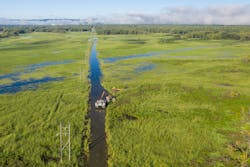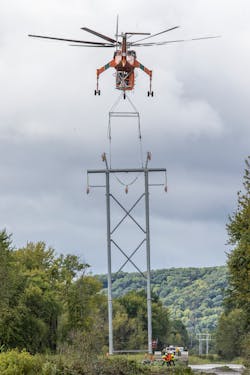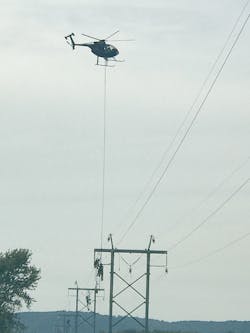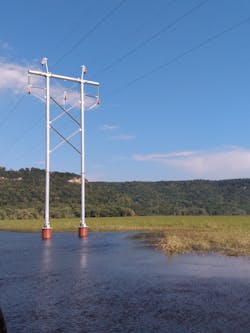Transmission Line Rebuild in Backwaters of Mississippi
Xcel Energy’s 69-kV transmission line crossing a national wildlife refuge on the northern reaches of the Mississippi River — near Nelson, Wisconsin, U.S., 70 miles (113 km) southeast of Minneapolis, Minnesota, U.S. — is just 2.7 miles (4.3 km) long. However, replacing this short segment of a more than 80-year-old line posed significant challenges for design, access and construction.
Originally built in 1934, the line serves the border towns of Nelson, Wisconsin, and Wabasha, Minnesota, while providing an important grid connection between the two states. At that time, the line’s wooden H-frame structures were set mostly on dry ground interspersed with streams and wetlands as the line extended westward from Nelson toward the Mississippi River. A year later, in 1935, much of the route was submerged by 2 ft to 3 ft (0.6 m to 0.9 m) of water after the completion of lock and dam No. 4, located approximately 7 miles (11 km) downstream on the Mississippi. Today, as part of the 240,000-acre (97,125-hectare) Upper Mississippi River National Wildlife and Fish Refuge, the area is an important environmental resource providing habitat for protected species as well as year-round recreation for hunters, anglers and boaters.
Despite decades in which their bases either were submerged or had groundwater just below the soil surface, many of the existing wood pole structures performed well beyond their typical 50-year to 60-year life expectancy. Their service life was coming to an end in 2015 when three structures were temporarily stabilized and reinforced, with steel piles driven adjacent and secured to the existing wood poles. However, because of its age and condition, a 2.2-mile (3.5-km) long segment, beginning near the Nelson substation and extending westward to the last structure before the Mississippi River crossing, warranted a more permanent solution.
Less Is More
Faced with the challenges of designing a low-impact solution in an environmentally sensitive area with difficult access, Xcel Energy’s team initially examined the possibility of rerouting the transmission line or simply retiring it altogether. The utility tabulated input from permitting, engineering and construction staff to evaluate the various options and their corresponding costs, benefits and feasibility. Ultimately, the best option was to replace the line in the same alignment corridor.
As if the unique terrain was not challenging enough, system operation considerations dictated the total consecutive, non-restorable line outage duration must be limited to two weeks, significantly less than even a typical project of this kind in standard conditions. Fortunately, working in the utility’s favor was the ability to take temporary line outages as long as service could be restored quickly if needed. This meant the two-week outage clock would not start ticking until removal of the existing transmission line began.
Project cost was an important consideration for replacing this short stretch of 69-kV line. Although wetland conditions are common in Xcel Energy’s northern service territory, the utility understood access and construction in several feet of water within a federal wildlife refuge would require unconventional equipment and different techniques than those used in typical rebuilds on land, with corresponding cost and environmental impacts. The utility determined fewer structures would reduce the number of access locations, quantity of material and overall labor effort, while also helping to meet the limited outage duration goal. The trade-off would be slightly taller and more robust structures and foundations, but this was balanced by the added benefits of fewer environmental impacts and less impediments to recreational use of the refuge.
Xcel Energy’s team developed a design that reduced the number of tangent structures from 25 to 15. The utility selected galvanized steel H-frames as replacement structures because of their anticipated longevity and resistance to deterioration caused by water levels that fluctuate by up to 11 ft (3.4 m) — or even more in a 100-year flood event, for example — from the normal pool elevation. The choice of an ultra-high-strength conductor — Southwire’s 477.0 kcmil Hen/ACSS/TW HS285 — mitigated sag and enabled structures to be only 5 ft (1.5 m) taller on average than with standard conductor. The utility’s decisions included frequent and open communication with the U.S. Fish and Wildlife Service during the design development process. This collaboration enabled the utility to discuss various options and work together toward an optimal solution for all stakeholders.
Foundation Design
Xcel Energy engaged POWER Engineers Inc. to provide consulting on foundation alternatives and design. First in this stage of the project, the utility contracted American Engineering Testing Inc. to perform subsurface geotechnical explorations with assistance from J.F. Brennan Co. Inc., which transported the drilling rig to site locations with a specially modified marsh buggy. Most locations consisted of varying depths of interbedded layers of swamp deposits and alluvium with blow counts frequently between 0 and 10 until depths exceeded 30 ft (9 m). Risks for scour under high flow, or flood, conditions were identified in portions of the project with open water as well as possible ice forces during the severe Wisconsin winters, when yearly low temperatures below –20°F (–29°C) are common.
The design team evaluated several different foundation types, considering factors such as equipment access limitations, environmental impacts, outage duration needs and cost. The shallow water made barges for transport and as a working platform for heavy equipment unsuitable. Therefore, foundations that could be installed prior to removal of the existing transmission line using minimal equipment became the focus of the investigation.
Ultimately, the team chose a helical pile and grillage system for the primary tangent structure foundation type. This provided a solution that could reach the depths necessary for adequate soil support, be installed by a marsh excavator and be lightweight enough for an airboat to transport it to each structure location. Four helical piles, driven to depths ranging from 40 ft to 90 ft (12 m to 27 m), supported each galvanized steel grillage, which included a baseplate and anchor bolts for connecting the poles to the grillage. Atlas Foundation Co. installed foundations for 11 tangent structures from December 2018 to January 2019, during frozen conditions.
For the four structures sited in open water areas where ice exposure was a concern, Xcel Energy chose 42-inch (107-cm) diameter steel caissons for the foundations. Lengths that varied from 56 ft to 62 ft (17 m to 19 m) were fitted with a baseplate connection and anchor bolts for attachment to the same H-frame tangent structures used with the helical pile and grillage foundation system. Driving ears, or tabs, attached to the baseplate enabled driving to be performed with a vibratory hammer.
To address corrosion of both helical piles and caissons, Xcel Energy used a layered approach by adding approximately 1/8-inch (0.3-cm) sacrificial steel thickness, applying galvanizing and special corrosion-resistant coatings in the upper regions of the foundations.
Fortunately, the terminal dead-end H-frames on each end of the project were both located on dry land. Unlike many of the other foundation locations, the utility could access these two with conventional construction equipment, so it chose reinforced concrete piers for these heavily loaded structures. By offsetting these structures in alignment with the existing wooden dead-ends, Xcel Energy was able to place the piers by its civil crews during the temporary line outages phase, before the remaining construction. To minimize ground disturbance, Xcel Energy crews also installed one-quarter mile of composite mats on the access route to the westernmost structures.
In-Flight Construction
With the helical pile and concrete pier foundations already in place, the remaining project components needed to be installed within the two-week transmission line outage constraint. Other limitations, including eagle nesting in the area, precluded construction for much of the first half of the year, while late fall was blocked out for waterfowl hunting season. Xcel Energy settled on starting construction in early September 2019, hoping for good weather and minimal rainfall. If the water level rose and submerged the grillages, it would be unable to install the structures and work would need to be delayed.
Helicopter assistance during construction was an ideal solution to the dual challenges of minimizing both the duration of work and environmental impacts. Only one staging and landing site was required because the project length was short, and Xcel Energy already owned suitable property near the Nelson substation. It employed an Erickson heavy-lift aircrane to transport large components, while Haverfield Aviation provided a lighter, construction-support helicopter for wire removal and stringing operations. J.F. Brennan supplied the specialized marsh equipment and airboats to transport workers and material for ground-based operations.
Installation of the vibratory caissons concerned the team, as tolerances of the H-frame structure legs left little room for horizontal or rotational deviations. In addition, the massive caissons had a one-way ticket to their deep destination — there would be no second chance to extract and reset once driving began. To prevent misalignment issues, J.F. Brennan designed, built and installed customized driving guide templates that not only supported the caissons during driving but also maintained their critically important spacing and proper rotational alignment.
After picking up each caisson at the storage yard, the aircrane transported it to the structure locations and positioned it in the guide template while the ground crew secured it under 60-mph to 70-mph (97-kmph to 113-kmph) rotor wash-induced winds and water spray. Next, the helicopter retrieved the vibratory hammer and set it on the caisson’s driving ears while ground crews connected hydraulic leads to the power unit mounted on a pre-positioned marsh buggy below. With the hammer in place, the aircrane departed and the caisson was driven to the specified depth. With the caisson installation complete, the vibratory hammer was aerially transported either back to the yard or to the next caisson. The driving templates, in addition to the skill demonstrated by both the helicopter and ground crews, proved to be critical elements of successful caisson installation.
However, all the planning and effort did not prevent the caissons from giving Xcel Energy a surprise. When the utility drove the first caisson, it found firmer substrate soils than expected and the caisson could not be driven the last 3 ft (0.9 m) to the desired depth. Because engineering staff were on-site to witness the ongoing work, the construction and engineering teams immediately conferred and assessed options. Fortunately, the project design provided enough flexibility to allow some additional structure height, so the utility was able to proceed without any other corrective action other than ensuring the caisson for the opposite H-frame leg was driven to match. Caissons for the remaining structures were installed to their design depths without issue.
Once the final caisson foundation was completed, the aircrane transitioned to setting all 15 tangent H-frames that had been preassembled and staged at the storage yard. Xcel Energy transmission line construction crews performed ground support and conventional dead-end H-frame installations. Xcel Energy line crew and the smaller support helicopter were used to string the conductor. Despite several days of weather delays that made flying conditions unsuitable, the new transmission line was completed and energized one day ahead of schedule, just as recent heavy rainfall in the upstream watershed was causing water levels to rise.
A Refined Plan
Months of preparation and gaining consensus before the work began was key to accomplishing this complex work within such a narrow time frame. Xcel Energy repeatedly refined the design and construction planning for the project as it collaborated with the U.S. Fish and Wildlife Service, U.S. Army Corps of Engineers, Wisconsin Department of Natural Resources, six construction crews from five different organizations and material suppliers.
In the end, both construction and engineering teams overcame the many challenges of building a transmission line in a difficult and sensitive environment within a limited time frame. The utility implemented some innovative and cost-effective solutions, maintained system reliability, minimized environ-mental impacts and limited the need for future maintenance in upcoming years.
Christopher Strom is a transmission line engineer with Xcel Energy. His primary focus is designing structures and foundations for both new construction and end-of-life replacement projects, but he also serves on several engineering standards teams and as a subject matter expert responsible for coordinating supplies of critical emergency repair materials. He earned his BSCE degree from Michigan Technological University.
Simon Murley serves as a project engineer and department manager at POWER Engineers. He is an expert in foundation and earth retention design, and transmission line design and modeling. He also is the subject matter coordinator for POWER Engineers’ foundation subject matter team, a collaboration of experts throughout the country. Murley earned his BSCE degree from Michigan State University and his master’s degree in 2010 from Lawrence Technological University, where he studied geotechnical engineering and served as an adjunct faculty in the civil engineering department. His research in geotechnical engineering has been published by the American Society of Civil Engineers, and he is a contributing author on publications for the Deep Foundation Institute.
About the Author
Christopher Strom
Christopher Strom is a transmission line engineer with Xcel Energy. His primary focus is designing structures and foundations for both new construction and end-of-life replacement projects, but he also serves on several engineering standards teams and as a subject matter expert responsible for coordinating supplies of critical emergency repair materials. He earned his BSCE degree from Michigan Technological University.
Simon Murley
Simon Murley serves as a project engineer and department manager at POWER Engineers. He is an expert in foundation and earth retention design, and transmission line design and modeling. He also is the subject matter coordinator for POWER Engineers’ foundation subject matter team, a collaboration of experts throughout the country. Murley earned his BSCE degree from Michigan State University and his master’s degree in 2010 from Lawrence Technological University, where he studied geotechnical engineering and served as an adjunct faculty in the civil engineering department. His research in geotechnical engineering has been published by the American Society of Civil Engineers, and he is a contributing author on publications for the Deep Foundation Institute.





